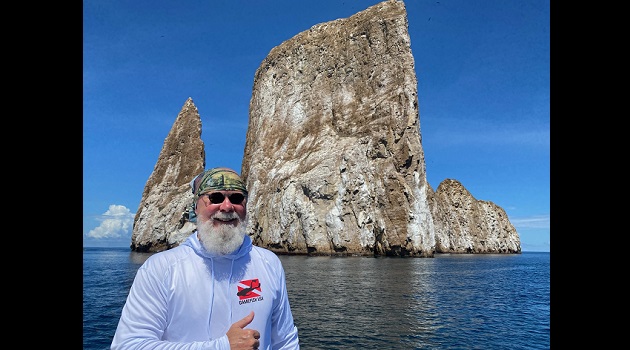By Tom Mullikin
I recently departed one paradise, the beautiful Palmetto State, to visit another, the famed Galápagos Islands, Ecuador. Over the last twelve years, I have been blessed to spend time in the Galápagos as a professor focusing on the impacts of amplified global climate change.
On this trip however, I traveled as a guest with the premier travel and touring company, METROPOLITAN TOURING (https://www.metropolitan-touring.com/) where I delivered a lecture on the implications of climatic changes and effects on biodiversity on Metropolitan’s beautiful ship La Pinta to guests from the United States, the United Kingdom, Australia, Ecuador and other areas around the world. My traveling partner was Felipe Andrade, a biotechnology engineer and the Carbon and Biodiversity Management Coordinator with Metropolitan’s foundation – Fundación Futuro.
Metropolitan has distinguished itself as an industry leader in responsible tourism preserving the environment and supporting communities in each of their diverse and biologically significant destinations. Their operations are carbon neutral and they offer their guests the means to offset their footprint while in travel. Their staff of naturalists are brilliant and patient as they impart their knowledge to everyone on board.
Traveling to Ecuador has been amazing to witness where 10 percent of all of the planet’s plant species live. Metropolitan explains that Ecuador offers its visitors a unique blend of natural beauty, fascinating history, and vibrant culture. It is home to a rich indigenous culture, with traditional markets, festivals, and artisan communities that highlight Ecuador’s vibrant heritage. Scientists have found that of the 12 most important biodiversity areas worldwide three are located in mainland Ecuador. The country’s 25,000 species of trees for example are a reflection of the tremendous climatic diversity.
Having spent more than a decade traveling to the Galápagos Islands I am never disappointed in the vast number of endemic species I find on each trip (endemic species are those not found anywhere else on Earth). The islands are a wonderland and unique ecological laboratory. As I have traveled around the world I have found no place where there is such an amazing and high concentration of unique wildlife.
On this expedition, I arrived at the Seymour Airport on Baltra Island. This airport was originally established by the U.S. Air Force to help monitor and protect the western access to the Panama Canal. We were met at the airplane by endemic species and went straight to La Pinta to enjoy the islands. The Charles Darwin Foundation has found that the Galapagos is home to over 9,000 species of flora and fauna. There are 56 native bird species of Galapagos, 45 are endemic and 11 are indigenous (native to Galapagos but also found elsewhere).
As we enjoyed the islands I was reminded about the indescribable beauty and unique ecosystem with vast endemic species. These include 250 endemic species of vascular plants; 20 endemic species of reptiles including the famed giant tortoise; five endemic species of land mammals; six endemic species of seabirds including the Galapagos Penguin, the Flightless Cormorant, and the Waved Albatross; 22 endemic species of land birds including the Darwin finches; 1,200 endemic species of terrestrial invertebrates; 580 endemic species of Marine Life; two species of marine mammals including the Galapagos Sea Lion and Galapagos Fur Seal; and 86 endemic species of fish.
Even after more than a dozen years, I remain amazed at the living laboratory of the Galápagos Islands. I also find tremendous similarities between our beautiful Palmetto State and the country of Ecuador. From the mountains to the sea, both places boast unimaginable natural beauty with diverse ecosystems.
Ecuador has the highest place on earth – Mt. Chimborazo. And South Carolina has some of the oldest mountains on Earth. Ecuador has attractive beaches and the singularly amazing Galápagos Islands. South Carolina has the most beautiful white sand beaches on earth. Both places have brilliant scientists and a deep history. Both places are defined by the humility and gracious hospitality of their residents. Metropolitan Touring has been the perfect host for this magnificent visit.
Two years ago after initiating our world-class SouthCarolina7 expedition (southcarolina7.com), we began a similar expedition in Ecuador entitled the Great Naturalist Trail (please see – https://youtu.be/N0Wr2B_nAoY).
So whether you are interested in a unique trip to the Andes and the Galapagos with Metropolitan or across the stunning ecosystems of the Palmetto State, join us as we introduce, educate and activate people to protect our beautiful Lord’s Garden.
– Attorney, professor, and global expedition leader Dr. Tom Mullikin chairs the S.C. Floodwater Commission.



